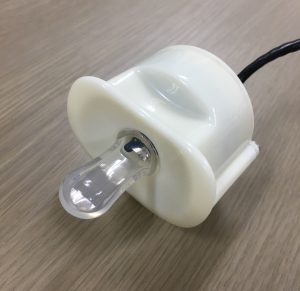
July 7, 2017
平成30年度 学府 入試説明会 開催報告A report on orientation for the 2018 GSII entrance examination
2017年6月10日(土)、平成30年度学際情報学府入試説明会が本郷キャンパスの福武ホールで開催されました。360名を超える受験生が集まり、熱気に包まれた説明会となりました。
学際情報学府と各コースの紹介
説明会の前半では、学府長と専攻長からのご挨拶と、コース長の先生方からのコース紹介がありました。学府長や専攻長からは、学環の理念、組織編成、コースの系譜などが紹介されました。各コース長の先生方からも、学際、情報、社会、について多面的に捉えた興味深いお話がありました。今年のニュースは、平成30年度に新設される生物統計情報学コースの入試説明が加わったことです。医療分野における臨床試験データを統計的に管理・解析できる専門家を養成するコースで、更なる学問分野の展開に期待が高まります。
各研究室のブース展示
説明会の後半にあるブース展示は、文系、理系の研究が一堂に会する入試説明会のメインイベントです。今年は学生さんや研究員の方にスポットを当てて、いくつかの展示を紙面でご紹介します。
文人コース開研D1の山内聡さんは、吸てつ反応の強度が計測できる「デジタルおしゃぶり」(動画)を使って、赤ちゃん研究の方法論を変えようとしています。これまでの研究では、乳児が何かを受動的に観察する様子(例:注視時間)から、その認知能力(例:視力、色覚、空間知覚)が解析されてきました。しかし、デジタルおしゃぶりにより、乳児が能動的に操作する様子が観察可能になります。赤ちゃんがアクション(吸てつの強弱や休むパターン)によって、現象の実験者そのものになったとき、どのような行動の変化が起こるのか?認知の発達は進むのか?このような挑戦的な問いに答えるべく研究を進められているそうです。
分析コース暦本研D1の松田暁さんは、身長が相手の目線に合わせて伸縮するテレプレゼンスロボット、ScalableBody(ウェブサイト)を紹介してくれました。移動機構の上に75cmから2mまで伸縮可能な棒状の構造があり、その先に360度の視野を持つカメラとユーザの顔を表示するディスプレイがあります。ユーザは遠隔地の人に並走しながら周囲を眺める体験ができ、また子供から大人まで相手と目線が合うので容易に対話ができます。身体の物理的制約を解除するだけでなく、それを実現する装置により身体能力が拡張(例:身長の伸縮、視野の広がり)されることで、コミュニケーションが円滑になる仕掛けに今後も興味を持たれているそうです。
社情コース三谷研M2の金信行さんは、フランスの科学社会学/科学人類学者のブルーノ・ラトゥールが提唱したアクターネットワーク理論を考察しようとしています。いわゆるメインストリームの社会学理論が個人や集団などの「人間」を社会現象を構成する基本要素としているのに対し、アクターネット理論は人間以外のもの、たとえば機械、動物、自然などの「非人間」も社会現象を構成する「アクター」として扱い、社会における現象を記述し捉えようとしたものです。金さんは、これを、まずは社会学の学説史のなかに位置づけ、さらには社会学の方法論として科学哲学の知見を用いて評価しようとしています。現代社会が技術の変容などの人間以外の要素を無視しては語れなくなりつつあるという問題意識が、研究の動機となっているそうです。
表現コース稲見研特任研究員の脇坂崇平さんは、とても不思議な体験をさせる代替現実(Subsititutional Reality)の研究を紹介してくれました(動画)。ユーザに、ヘッドマウントディスプレイ、ヘッドフォン、ライブカメラ、方位センサのついた特殊な装置をかぶせると、ユーザに提示される視覚・音声情報が、完全に操作可能な状態になります。その状態で、現在のライブの映像・音声と過去に撮影しておいたものとを交互に繰り返し体験させると、ユーザはそのうちに今見ている映像が過去の映像なのか、現実なのか、分からなくなって、時間認知に影響を与えることができます。さながら、覚醒しながら夢を見ている様な体験です。この新しい装置により、人間の認知・心理の新しい知見が得られる可能性を示しています。
最後に、新設された生物統計コースの先生方にお話しを伺いました。特に日本では新しい薬品の臨床データなどを統計的に管理し分析する、医療における生物統計家が不足しているために、様々な問題が起こり、またライフサイエンスの発展が遅れているそうです。統計学の素養があり、また医療に携わる高い志を持った学生を広く募集しているとのことでした。
以上、学環・学府の振り幅を改めて感じた今年度の入試説明会報告でした。
記事:川上玲(助教)
写真:濱田健夫(助教)
英文校正:デイビッド・ビュースト(特任専門員)
On June 10th, 2017, orientation for the 2018 entrance exam of GSII (Graduate School of Interdisciplinary Information Studies) was held at Fukutake hall on Hongo campus. The atmosphere at the meeting was enthusiastic, and more than 360 students participated.
Introduction of GSII and its courses
The dean and the chairperson gave opening speeches about Gakkan’s mission, structure, and history of the courses. Course directors then gave introductions for each course, and discussed what it means to be interdisciplinary, how to handle information, and how to interact with society. The news of this year is the establishment of the Biostatistics and Bioinformatics Course, which will start receiving students in the academic year of 2018 with the aim of educating experts who can design, collect and analyze clinical investigation data statistically.
Exhibition of laboratories
There were exhibitions from individual laboratories in both the arts and sciences. This article introduces presentations highlighting several students and one researcher.
Satoshi Yamauchi, a first-year Ph.D candidate at Hiraki Lab in the Cultural and Human Studies Course, is trying to change the methodology of infant studies by utilizing a digital dummy (video) which can measure the strength of suckling. The cognitive abilities of babies (eyesight, perception of color, space, etc.) are analyzed in general by observing their passive reactions (e.g., gaze duration). However, the digital dummy is an actively manipulative tool for babies. When babies have manipulative power to experiment, how do they act, and do their cognitive abilities grow by learning those actions? Satoshi is trying to answer these challenging questions through his research.
Akira Matsuda, a first-year Ph.D candidate at Rekimoto Lab in the Applied Computer Science Course, introduced his telepresence robot, ScalableBody, whose height adaptively varies to the conversational counterpart(website). There is a camera with 360-degree field-of-view and a display that shows the user’s face, attached on top of a structure whose height is variable from 75 cm to 2 m, and the whole body is on a mobile platform. With this robot, a user can look around and walk beside people in remote locations, having eye-to-eye communication. Akira is interested in methods that facilitate communications not only by releasing physical constraints but also by augmenting human’s physical ability (e.g., height, field-of-view, etc).
Nobuyuki Kim, a second-year Master student at Mitani Lab in the Socio-information and Communication Studies Course, is reexamining the actor-network theory proposed by Bruno Latour, a French sociologist and anthropologist. The mainstream of sociological theories targets humans (e.g., individual, crowd) as the fundamental element of the structure of social phenomena, but the actor-network theory handles non-humans, such as machines, animals, nature, as “actors” that are equally constitutive of social phenomena. Nobuyuki is first trying to map the theory from a historical perspective, and then evaluate it as a sociological methodology using knowledge from the philosophy of science. He is motivated by the idea that modern society cannot be fully explained unless we take into account non-human factors such as drastic technological change.
Sohei Wakisaka, a project researcher at Inami Lab in the Emerging Design and Informatics Course, who used to work at Riken, introduced us to his research about the strange and wonderful world of substitutional reality (video). When a user puts on a helmet with a head-mount display, headphones, camera, and orientation sensor, the visual and audio inputs to him/her can be fully controlled. With this device, Sohei found that by letting a user experience past and present scenes alternately and repetitively, he/she looses sense of whether he/she is seeing past or present scenes, and their time cognition is impacted. The experience is like dreaming while awake. With this new device, we may be able to collect further knowledge about cognition and psychology.
I also had an interview with professors at the new course on biostatistics and bioinformation studies. Particularly in Japan, many problems arise because of the lack of biostatisticians with expert knowledge on how to analyze data from new drug trials and other medical investigations, and this slows down the development of life science in Japan. The new course is recruiting students who know the basics of statistics and have a high motivation for health care.
Text: Rei Kawakami(Assistant professor)
Photo: Takeo Hamada(Assistant professor)
Proofreading: David Buist(Project senior specialist)





